You are using an out of date browser. It may not display this or other websites correctly.
You should upgrade or use an alternative browser.
You should upgrade or use an alternative browser.
Reviews by rebbi
Filters
Show only:
Loading…
rebbi
100+ Head-Fier
Pros: Small, thin, and lightweight.
MQA hardware decoding
Big, bold sound, with excellent rendering of imaging and spatial cues
Great synergy with the Hidizs MP145 IEM's
Bargain price
MQA hardware decoding
Big, bold sound, with excellent rendering of imaging and spatial cues
Great synergy with the Hidizs MP145 IEM's
Bargain price
Cons: Lack of hardware volume adjustment
LED lighting feels like a gimmick
LED lighting feels like a gimmick
I must begin this review with an apology to Hidizs! I received the product reviewed here several months ago. Unfortunately, moving to a new house and preparing to start a new job delayed the publishing of this review.
As I began to compose this review of the Hidizs XO dongle DAP and amplifier, I started counting and realized that I have purchased a lot of their products over the years.
It all started when I had a pair of the Blon-03 IEM's (which you may remember were all the rage a number of years ago, said to be the latest, low-priced "giant killer" IEM on a number of headphone forums and YouTube reviews).
Sometime later, after I purchased the EarStudio ES-100 Bluetooth DAC/amplifier, I really wanted to try the BL-03's with the ES-100's 2.5 mm balanced output. Looking on Amazon.com, I found the perfect cable, at a very reasonable price, made by an unknown (to me) Chinese company called Hidizs. The cable came, nicely packaged and of good quality, and it did the job.
 More of their products followed. Based on a rave evaluation from the website Audio Science Revue, I purchased the Hidizs S9 Pro dongle DAC, which sounded great. I especially like the industrial design: metal around the edges and glass on the front and back. It looked and felt like a high-quality product, at a very reasonable price.
More of their products followed. Based on a rave evaluation from the website Audio Science Revue, I purchased the Hidizs S9 Pro dongle DAC, which sounded great. I especially like the industrial design: metal around the edges and glass on the front and back. It looked and felt like a high-quality product, at a very reasonable price.
Much later on, as Hidizs began to expand their product lineup, I was intrigued by their tiny AP80 Pro X digital audio player and matching amplifier, and gave it a try, as well. The sheer "cuteness" of that diminutive player combined with the matching DH80 DAC/amp, yielded remarkably fine sound quality.
 The combo impressed me enough that when I learned that the company was looking for customers to review their new XO, MQA capable dongle DAC and amplifier, I wanted to give it a try. I was particularly interested because I still have the company's older S9Pro DAC/amp combo dongle, and wanted to see how the two of them compared.
The combo impressed me enough that when I learned that the company was looking for customers to review their new XO, MQA capable dongle DAC and amplifier, I wanted to give it a try. I was particularly interested because I still have the company's older S9Pro DAC/amp combo dongle, and wanted to see how the two of them compared.
The usual disclaimer: Hidizs supplied me with a sample of the XO product in exchange for this unbiased review.
There are already lots of reviews of the XO on Head-fi.com, many of them duplicating similar information such as the manufacturer specifications, un-boxing photos and so forth. In this review, therefore, I'll focus on my listening impressions, and some comparisons that I haven't seen elsewhere.
 I tested the XO with two different IEM's, the Campfire Andromeda (2019 version), and Hidizs' very own MP145 planar magnetic earphones. I was also very curious to try the XO driving my Audeze LCDi4 planar magnetic IEM's, but they require equalization to sound the way they should, and I didn't have the time to install and configure a systemwide equalizer on my 14 inch, M3 MacBook Pro. When I do have the chance to try that, I will append the results to this review.
I tested the XO with two different IEM's, the Campfire Andromeda (2019 version), and Hidizs' very own MP145 planar magnetic earphones. I was also very curious to try the XO driving my Audeze LCDi4 planar magnetic IEM's, but they require equalization to sound the way they should, and I didn't have the time to install and configure a systemwide equalizer on my 14 inch, M3 MacBook Pro. When I do have the chance to try that, I will append the results to this review.
Physically, the XO is slightly shorter but substantially wider than the older, S9 Pro. The additional width possibly results from the fact that the XO places its two headphone jacks next to each other, whereas the older S9 Pro stacks its outputs vertically, necessitating a somewhat awkward bulge at the output end of the dongle.

 Anyway, the build quality of the XO seems fine. I do like the rose gold color, although I have some concerns about how the finish will hold up when placed into your average jeans pocket with coins, keys, and other such common objects. Additionally, the XO also feels the tiniest bit heavier then the S9 Pro, although both of them are extremely light in weight.
Anyway, the build quality of the XO seems fine. I do like the rose gold color, although I have some concerns about how the finish will hold up when placed into your average jeans pocket with coins, keys, and other such common objects. Additionally, the XO also feels the tiniest bit heavier then the S9 Pro, although both of them are extremely light in weight.
If you are interested in a detailed comparison of the technical specifications of both dongles, visit this page on the Hidizs web site, scroll down about 2/3 of the page, and you'll find a chart with detailed comparisons of the two products.
I'll just highlight the fact here that both of them have a USB-C data port, along with two headphone outputs: 2.5 mm balanced, and 3.5 mm single ended. Because I ordered my Hidizs MP145 earphones with a 4.4 mm, balanced connector, I was happy that several years ago I purchased a ddHifi DJ44b adapter, that converts a 4.4 mm balanced plug into a 2.5 mm balanced plug. Problem solved!
 Sources included high resolution MQA and and FLAC files from Tidal on my iPhone 14, connected using Hidiz's OTG USB-C to Lightning cable, and Tidal tracks connected to my M3 MacBook Pro via USB-C. Speaking of cables, I was disappointed with the build quality of the USB-C male-to-male cable that Hidizs supplied with the XO. The metal collar slides back and forth because of a sloppy glue job. In my experience, not typical of the build quality of Hidizs products.
Sources included high resolution MQA and and FLAC files from Tidal on my iPhone 14, connected using Hidiz's OTG USB-C to Lightning cable, and Tidal tracks connected to my M3 MacBook Pro via USB-C. Speaking of cables, I was disappointed with the build quality of the USB-C male-to-male cable that Hidizs supplied with the XO. The metal collar slides back and forth because of a sloppy glue job. In my experience, not typical of the build quality of Hidizs products.
 So, how does everything sound?
So, how does everything sound?
First, the Hidizs XO is an excellent match with the Hidizs MP145 planar magnetic earphones. Listening to tracks like "Harbor Lights" by Boz Skaggs (which is a great headphone showpiece), the studio reverberation of the Fender Rhodes electric keyboard sounds cavernous, and the shaker (percussion) that travels back and forth between the right and left channels during the intro seems to move way outside the listener's head. The XO driving the MP145's also does a fine job separating instrumentals and voices. Nothing sounds smeared or blurry. Basking in the Eagles' beautiful "I Can’t Tell You Why," Timothy Schmidt's angelic tenor is front and center, while the background vocals are intimate, distinct and detailed without any harshness. And again, the sense of acoustic space is impressive; this combo sounds immersive and huge. The same goes for "Chan Chan" from Buena Vista Social Club, especially when the muted trumpet solo begins and you can really feel the acoustics of the surrounding studio.
On the low end, I often use the song "Snowbound," from Donald Fagen's album, "Kamakiriad," with its plunging, swooping six string electric bass lines, as a test of how well earphones or speakers can render low bass notes. Lesser equipment will emphasize a thumping mid-bass, blurring the pitch and obscuring the gutty, string sound of the instrument. While the combination of the MP145's and the XO clearly fattened up the low end on this track to some degree, I didn't find it offensive and the bass guitar still sounded like a bass guitar.
Up to this point, I've been describing my experiences with the XO connected to the MacBook Pro. Although the sonic qualities of this combination were similar with the XO attached to my iPhone 14, also streaming high resolution tracks from Tidal, I did run into a vexing issue. Using the up and down volume buttons on the iPhone, I found volume adjustments to be far too great with each button press. For example, the jump upward from "a little too soft" to "way too loud" just took a single press on the volume up button on the phone. Of course, every earphone and headphone will present a different load to the XO, so this volume "problem" may be specific to the earphone in question, in this case, the MP145. Volume adjustment increments were much more reasonable using my 2019 Campfire Andromeda IEM's, although I wasn't as enamored of the sonic results that this combo produced. There was something a little dull and lifeless to the presentation. Note, however, that these differences may be attributable to the Andromeda being driven by the single-ended output, since I don't have a balanced cable for them.
I'll go a bit further here and say that I wish that Hidizs had included hardware volume adjustments on the XO, and left out the flashing, multicolored LEDs on the sides of the dongle. (The pattern of flashing lights changes with each press on the "X" button on the dongle.) I suppose some people will find this little light show to be fun, but, as I said, I'd rather have hardware volume adjustment. This, by the way, is why I just placed an order for the recently released Hidizs S8 Robin DAC/amp, which does have a volume knob. I hope to review that unit when I receive it.
In the end, paired with the right earphones the Hidizs XO is a great sounding DAC/amplifier worthy of your consideration, especially when matched with the Hidizs MP145's. If you can live without hardware volume adjustment, it's worth checking out.
As I began to compose this review of the Hidizs XO dongle DAP and amplifier, I started counting and realized that I have purchased a lot of their products over the years.
It all started when I had a pair of the Blon-03 IEM's (which you may remember were all the rage a number of years ago, said to be the latest, low-priced "giant killer" IEM on a number of headphone forums and YouTube reviews).
Sometime later, after I purchased the EarStudio ES-100 Bluetooth DAC/amplifier, I really wanted to try the BL-03's with the ES-100's 2.5 mm balanced output. Looking on Amazon.com, I found the perfect cable, at a very reasonable price, made by an unknown (to me) Chinese company called Hidizs. The cable came, nicely packaged and of good quality, and it did the job.

Much later on, as Hidizs began to expand their product lineup, I was intrigued by their tiny AP80 Pro X digital audio player and matching amplifier, and gave it a try, as well. The sheer "cuteness" of that diminutive player combined with the matching DH80 DAC/amp, yielded remarkably fine sound quality.

The usual disclaimer: Hidizs supplied me with a sample of the XO product in exchange for this unbiased review.
There are already lots of reviews of the XO on Head-fi.com, many of them duplicating similar information such as the manufacturer specifications, un-boxing photos and so forth. In this review, therefore, I'll focus on my listening impressions, and some comparisons that I haven't seen elsewhere.

Physically, the XO is slightly shorter but substantially wider than the older, S9 Pro. The additional width possibly results from the fact that the XO places its two headphone jacks next to each other, whereas the older S9 Pro stacks its outputs vertically, necessitating a somewhat awkward bulge at the output end of the dongle.


If you are interested in a detailed comparison of the technical specifications of both dongles, visit this page on the Hidizs web site, scroll down about 2/3 of the page, and you'll find a chart with detailed comparisons of the two products.
I'll just highlight the fact here that both of them have a USB-C data port, along with two headphone outputs: 2.5 mm balanced, and 3.5 mm single ended. Because I ordered my Hidizs MP145 earphones with a 4.4 mm, balanced connector, I was happy that several years ago I purchased a ddHifi DJ44b adapter, that converts a 4.4 mm balanced plug into a 2.5 mm balanced plug. Problem solved!


First, the Hidizs XO is an excellent match with the Hidizs MP145 planar magnetic earphones. Listening to tracks like "Harbor Lights" by Boz Skaggs (which is a great headphone showpiece), the studio reverberation of the Fender Rhodes electric keyboard sounds cavernous, and the shaker (percussion) that travels back and forth between the right and left channels during the intro seems to move way outside the listener's head. The XO driving the MP145's also does a fine job separating instrumentals and voices. Nothing sounds smeared or blurry. Basking in the Eagles' beautiful "I Can’t Tell You Why," Timothy Schmidt's angelic tenor is front and center, while the background vocals are intimate, distinct and detailed without any harshness. And again, the sense of acoustic space is impressive; this combo sounds immersive and huge. The same goes for "Chan Chan" from Buena Vista Social Club, especially when the muted trumpet solo begins and you can really feel the acoustics of the surrounding studio.
On the low end, I often use the song "Snowbound," from Donald Fagen's album, "Kamakiriad," with its plunging, swooping six string electric bass lines, as a test of how well earphones or speakers can render low bass notes. Lesser equipment will emphasize a thumping mid-bass, blurring the pitch and obscuring the gutty, string sound of the instrument. While the combination of the MP145's and the XO clearly fattened up the low end on this track to some degree, I didn't find it offensive and the bass guitar still sounded like a bass guitar.
Up to this point, I've been describing my experiences with the XO connected to the MacBook Pro. Although the sonic qualities of this combination were similar with the XO attached to my iPhone 14, also streaming high resolution tracks from Tidal, I did run into a vexing issue. Using the up and down volume buttons on the iPhone, I found volume adjustments to be far too great with each button press. For example, the jump upward from "a little too soft" to "way too loud" just took a single press on the volume up button on the phone. Of course, every earphone and headphone will present a different load to the XO, so this volume "problem" may be specific to the earphone in question, in this case, the MP145. Volume adjustment increments were much more reasonable using my 2019 Campfire Andromeda IEM's, although I wasn't as enamored of the sonic results that this combo produced. There was something a little dull and lifeless to the presentation. Note, however, that these differences may be attributable to the Andromeda being driven by the single-ended output, since I don't have a balanced cable for them.
I'll go a bit further here and say that I wish that Hidizs had included hardware volume adjustments on the XO, and left out the flashing, multicolored LEDs on the sides of the dongle. (The pattern of flashing lights changes with each press on the "X" button on the dongle.) I suppose some people will find this little light show to be fun, but, as I said, I'd rather have hardware volume adjustment. This, by the way, is why I just placed an order for the recently released Hidizs S8 Robin DAC/amp, which does have a volume knob. I hope to review that unit when I receive it.
In the end, paired with the right earphones the Hidizs XO is a great sounding DAC/amplifier worthy of your consideration, especially when matched with the Hidizs MP145's. If you can live without hardware volume adjustment, it's worth checking out.
rebbi
100+ Head-Fier
Pros: Great sound, battery life and Bluetooth range. Latest firmware update mitigates some connectivity clumsiness.
Cons: Noise cancellation isn't best in class, clunky styling for some, "Side Tone" doesn't totally eliminate "stuffy head" sensation on phone calls.
Hi, Folks: These are concluding excerpts from my comprehensive review of the SENNHEISER MOMENTUM TW 2 Bluetooth IEM's. Note that this is the revised, version 2, which addresses the weaknesses (such as battery life) of the original version. I don't see any reviews of the newer version here, so I wanted to share this.
If you'd like to read the full review, its on my blog, Steve's Audio Blog. Enjoy!

PERFORMANCE:
I’ll get to the sound of the Momentum TW 2’s in a moment, but first let’s cover a few general performance parameters.
FIT — As for fit and other ergonomic considerations, I am quite pleased with the comfort of the Momentum TW 2’s. Fit is a very personal thing (unlike me, my wife finds her AirPod Pro’s super comfortable), so I’d always recommend purchasing any IEM’s or even full-size headphones from a dealer with a generous return policy. I find the Sennheiser’s to be almost forget-you’re-wearing-them comfortable, with a smooth inner surface devoid of sharp edges that might irritate the ear. Furthermore, at a mere 6 gm per side, the TW 2’s are among the lighter IEM’s out there.
BATTERY LIFE — The TW 2’s are currently my daily, go-to earbuds, and I don’t think I’ve ever received a low battery warning. Sennheiser claims 7 hours of continuous battery life, extendable to 28 hours with the battery case’s reserves. Additionally, the USB-C charging port on the case makes quick work of topping off the battery.
BLUETOOTH RANGE is excellent. I can leave my Bluetooth source in one room and and walk all over our two-story house (and even out onto the front porch) and rarely will the sound drop out or stutter. This is very impressive.
PHONE CALLS — I’ve found the Momentum TW 2’s to function reliably for making and receiving telephone calls, and I’ve never had a caller complain that my voice wasn’t coming through clearly on their end of the conversation. That said, I haven’t usually enjoyed taking calls on most wired or wireless earbuds or headphones because of the “stuffy head” sensation that makes it difficult to hear your own voice while you speak. The TW 2’s are supposed to alleviate this sensation through a feature Sennheiser calls Side Tone, which mixes the microphone input into the earbuds’ output. Unfortunately, unless I’m doing something wrong, I haven’t found Side Tone to create that open, natural sounding phone call experience. If my aural memory serves, the AirPod Pro’s did the best job of making phone calls sound relaxed and natural.
BLUETOOTH LATENCY, that is, the time lag inherent in Bluetooth transmission, is largely dependent on the codec (compression/decompression scheme) and hardware implementation of the transmitting and receiving devices. It’s not an issue with music files alone, but when video is involved, as in smart phone and computer games or movies and streaming videos, too much latency will result in a very irritating lack of synchronization between audio and video, causing sound effects and dialogue to lag behind the on-screen action. In the case of the Momentum TW 2, whether watching YouTube videos or playing a video game, I have found Bluetooth latency to be so minuscule as to be nearly imperceptible.
ACTIVE NOISE CANCELLATION is, frankly, slightly disappointing. Right now the Momentum TW 2’s are in my ears. I can hear the sound of my keyboard clicking as I type, but the “whooshing” of the central heat in my room is almost entirely deadened. I was also able to listen to music with our Roomba robot sweeper grinding away in the kitchen while doing the dishes with much of the noise of the Roomba muffled. On the other hand, the masking of other people’s conversations in line at Starbucks or construction noises in my neighborhood while I’m walking is only so-so. I fortunately did have the chance to use my TW 2’s on a commercial flight (yes, I was properly masked and socially distanced from other passengers) some months ago. Again, they did a decent job subduing jet engine and other noises during the flight, so that I didn’t have to crank the volume dangerously loud in order to hear my music over the drone of the engines, but you’re not going to get the kind of isolation that you’d experience with a pair of full-size, noise-cancelling headphones like my Sony WH 1000XM3.
THE SOUND
This is where the Sennheiser Momentum TW 2’s really shine. I am regularly startled by just how refined, lively and resolving they are. Listening, for example, to dense vocal harmonies, whether it’s Crosby Stills and Nash’s Helplessly Hoping or Billie Eilish’s Party Favor, nothing is smeared or obscured; pick out any vocal line you choose and it’s easy to follow. Indeed, well-recorded voices in general sound completely fleshed out and human.
Billie Eilish’s debut EP, “Don’t Smile at Me.”
The upper midrange and treble, too, are sweet and clear. By “sweet” I don’t mean rolled off or muffled, but rather that the Momentum TW 2’s don’t add any obnoxious emphasis (masquerading as “detail”) to the upper mids and highs. Cymbals and vocalists’ “s” sounds don’t feel like torture, unless the track was recorded with a synthetic, hard, vocal emphasis. (Lamentably, this is now par for the course in too many pop recordings, but at least the TW 2’s won’t add their own ugly edge to that bright, thin, studio equalization.)
The low end is pretty close to my ideal. The TW 2’s will dig very deep when that’s called for (the bass lines in the opening bars of Donald Fagen’s Morph The Cat come to mind) but the low end is well controlled and the default sound signature overall isn’t “dark” or “veiled” by the omnipresent mid-bass “hump” that plagues too many consumer oriented headphones and IEM’s. So yes, the TW 2’s will do justice to EDM and other genres that showcase fat synth bass lines.
Finally, the imaging and soundstage width and layering of the Momentum TW 2’s is shockingly good. Live albums like James Taylor’s classic Live 2-CD set put you in the theater, surrounded by happy, whooping JT fans. Well recorded pop albums like Sade’s Promise
 will thrill you with a nearly surround sound presentation, as in the organ/synth chords near the beginning of War of the Hearts.
will thrill you with a nearly surround sound presentation, as in the organ/synth chords near the beginning of War of the Hearts.
SUMMING UP
As noted earlier, the Sennheiser Momentum TW 2 Bluetoot IEM’s aren’t perfect: noise cancellation could be better, phone calls still have a somewhat “congested” feel, and they’re not the prettiest earbuds ever created, but for sheer musical pleasure, they’re a great pair of in-ear monitors. Sennheiser is a long-established, serious provider of professional and consumer microphones and headphones, and that lineage is amply manifested in the Momentum TW 2 IEM’s. Highly recommended.
That’s it for this post, everyone. See you next time… and in the meantime, be kind to others, stay safe, mask up, and enjoy your music!
Steve

If you'd like to read the full review, its on my blog, Steve's Audio Blog. Enjoy!

PERFORMANCE:
I’ll get to the sound of the Momentum TW 2’s in a moment, but first let’s cover a few general performance parameters.
FIT — As for fit and other ergonomic considerations, I am quite pleased with the comfort of the Momentum TW 2’s. Fit is a very personal thing (unlike me, my wife finds her AirPod Pro’s super comfortable), so I’d always recommend purchasing any IEM’s or even full-size headphones from a dealer with a generous return policy. I find the Sennheiser’s to be almost forget-you’re-wearing-them comfortable, with a smooth inner surface devoid of sharp edges that might irritate the ear. Furthermore, at a mere 6 gm per side, the TW 2’s are among the lighter IEM’s out there.
BATTERY LIFE — The TW 2’s are currently my daily, go-to earbuds, and I don’t think I’ve ever received a low battery warning. Sennheiser claims 7 hours of continuous battery life, extendable to 28 hours with the battery case’s reserves. Additionally, the USB-C charging port on the case makes quick work of topping off the battery.
BLUETOOTH RANGE is excellent. I can leave my Bluetooth source in one room and and walk all over our two-story house (and even out onto the front porch) and rarely will the sound drop out or stutter. This is very impressive.
PHONE CALLS — I’ve found the Momentum TW 2’s to function reliably for making and receiving telephone calls, and I’ve never had a caller complain that my voice wasn’t coming through clearly on their end of the conversation. That said, I haven’t usually enjoyed taking calls on most wired or wireless earbuds or headphones because of the “stuffy head” sensation that makes it difficult to hear your own voice while you speak. The TW 2’s are supposed to alleviate this sensation through a feature Sennheiser calls Side Tone, which mixes the microphone input into the earbuds’ output. Unfortunately, unless I’m doing something wrong, I haven’t found Side Tone to create that open, natural sounding phone call experience. If my aural memory serves, the AirPod Pro’s did the best job of making phone calls sound relaxed and natural.
BLUETOOTH LATENCY, that is, the time lag inherent in Bluetooth transmission, is largely dependent on the codec (compression/decompression scheme) and hardware implementation of the transmitting and receiving devices. It’s not an issue with music files alone, but when video is involved, as in smart phone and computer games or movies and streaming videos, too much latency will result in a very irritating lack of synchronization between audio and video, causing sound effects and dialogue to lag behind the on-screen action. In the case of the Momentum TW 2, whether watching YouTube videos or playing a video game, I have found Bluetooth latency to be so minuscule as to be nearly imperceptible.
ACTIVE NOISE CANCELLATION is, frankly, slightly disappointing. Right now the Momentum TW 2’s are in my ears. I can hear the sound of my keyboard clicking as I type, but the “whooshing” of the central heat in my room is almost entirely deadened. I was also able to listen to music with our Roomba robot sweeper grinding away in the kitchen while doing the dishes with much of the noise of the Roomba muffled. On the other hand, the masking of other people’s conversations in line at Starbucks or construction noises in my neighborhood while I’m walking is only so-so. I fortunately did have the chance to use my TW 2’s on a commercial flight (yes, I was properly masked and socially distanced from other passengers) some months ago. Again, they did a decent job subduing jet engine and other noises during the flight, so that I didn’t have to crank the volume dangerously loud in order to hear my music over the drone of the engines, but you’re not going to get the kind of isolation that you’d experience with a pair of full-size, noise-cancelling headphones like my Sony WH 1000XM3.
THE SOUND
This is where the Sennheiser Momentum TW 2’s really shine. I am regularly startled by just how refined, lively and resolving they are. Listening, for example, to dense vocal harmonies, whether it’s Crosby Stills and Nash’s Helplessly Hoping or Billie Eilish’s Party Favor, nothing is smeared or obscured; pick out any vocal line you choose and it’s easy to follow. Indeed, well-recorded voices in general sound completely fleshed out and human.
Billie Eilish’s debut EP, “Don’t Smile at Me.”
The upper midrange and treble, too, are sweet and clear. By “sweet” I don’t mean rolled off or muffled, but rather that the Momentum TW 2’s don’t add any obnoxious emphasis (masquerading as “detail”) to the upper mids and highs. Cymbals and vocalists’ “s” sounds don’t feel like torture, unless the track was recorded with a synthetic, hard, vocal emphasis. (Lamentably, this is now par for the course in too many pop recordings, but at least the TW 2’s won’t add their own ugly edge to that bright, thin, studio equalization.)
The low end is pretty close to my ideal. The TW 2’s will dig very deep when that’s called for (the bass lines in the opening bars of Donald Fagen’s Morph The Cat come to mind) but the low end is well controlled and the default sound signature overall isn’t “dark” or “veiled” by the omnipresent mid-bass “hump” that plagues too many consumer oriented headphones and IEM’s. So yes, the TW 2’s will do justice to EDM and other genres that showcase fat synth bass lines.
Finally, the imaging and soundstage width and layering of the Momentum TW 2’s is shockingly good. Live albums like James Taylor’s classic Live 2-CD set put you in the theater, surrounded by happy, whooping JT fans. Well recorded pop albums like Sade’s Promise

SUMMING UP
As noted earlier, the Sennheiser Momentum TW 2 Bluetoot IEM’s aren’t perfect: noise cancellation could be better, phone calls still have a somewhat “congested” feel, and they’re not the prettiest earbuds ever created, but for sheer musical pleasure, they’re a great pair of in-ear monitors. Sennheiser is a long-established, serious provider of professional and consumer microphones and headphones, and that lineage is amply manifested in the Momentum TW 2 IEM’s. Highly recommended.
That’s it for this post, everyone. See you next time… and in the meantime, be kind to others, stay safe, mask up, and enjoy your music!
Steve

rebbi
100+ Head-Fier
Pros: Soundstage, thunderous but not obnoxious bass, smooth, even, extended treble, large soundstage and great imaging, completely non-fatiguing sound.
Cons: Achieving proper fit takes some getting used to, isolation isn't top shelf.
MINI-REVIEW: The KEF M200 In-Ear Monitor
Posted on December 24, 2016 by rebbi1Why I’m Rushing This Review Out The Door
I normally spend a good number of hours, spread over many days, writing posts, especially reviews, for this site. I’ve never felt a lot of time pressure to “crank out posts,” as manifested in the generally leisurely pace of new posts on my site, Steve’s Audio Blog.I’m making an exception here, though, because the terrific product I’m reviewing today is currently on sale for less than half its normal retail price, direct from the manufacturer, and I want as many of you as possible to get in on this deal before it vanishes.
The KEF M200
I’d been looking for a reasonably priced IEM that could serve as both my everyday and “end game” earphone. I wanted something with an even, un-hyped treble, good imaging, large soundstage, realistic midrange tonality and substantial but not overpowering low end “grunt” when called for.I wouldn’t have considered the M200 if not for its enthusiastic inclusion, both this year and last, among the recommended IEM’s in Head-fi.org’s annual Buyer’s Guide. (Scroll down this page to see Head-fi Editor Jude Mansilla’s assessment of the M200.) The description of the M200’s virtues in the Buyer’s Guide checked all my preference boxes, and I managed to score an open-box pair on Amazon.com for around $100.
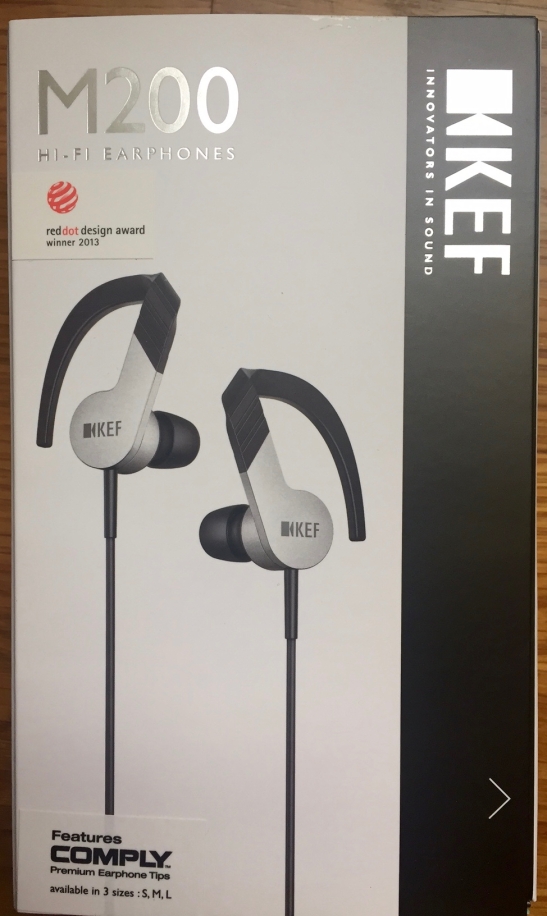
Package Front
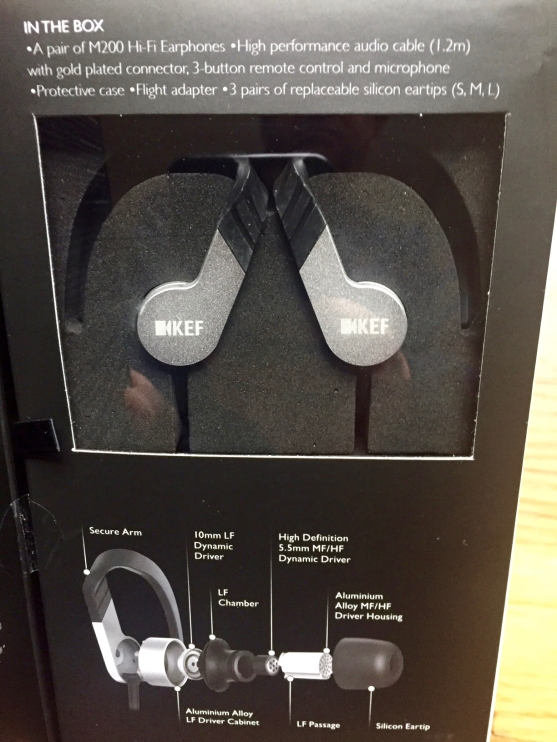
Behind the front package flap
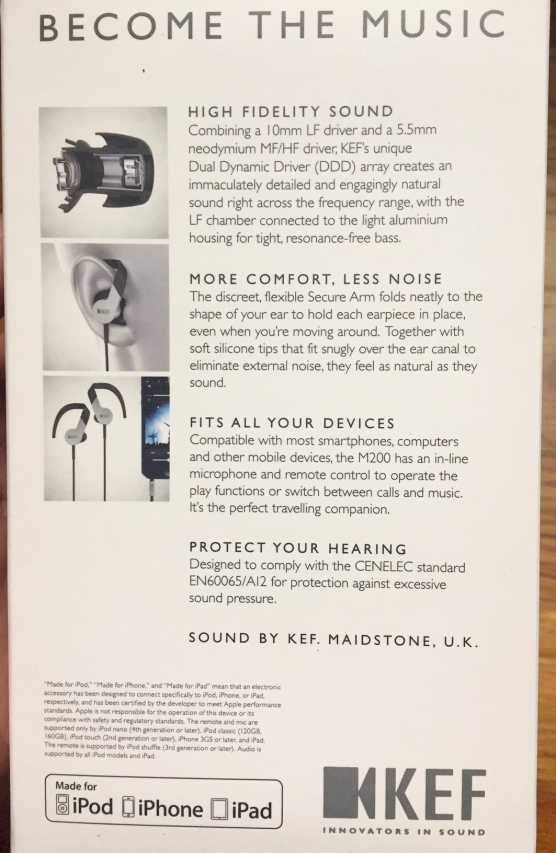
Package Back
I was also intrigued by the M200 due to my roots in high end home audio. KEF is a long established and deeply respected high end speaker manufacturer from the UK. Their stratospherically priced Blade and Muon floor standing speakers are widely considered two of the best out there, and their budget (by insane high end audio standards) and petite LS50 stand mount monitor has sold by the bucket-full since its introduction several years ago garnered ecstatic reviews in the audio press.
Basic Description
Without repeating a bunch of descriptive information that you can read on the M200 product page, suffice it to say that the M200 sports two, cleverly mounted dynamic drivers per housing: a bass driver and a mid-high driver. The treble driver is closest to the ear and the bass driver lives in its own chamber to the rear, with ports that deliver the low end around the treble driver and into the nozzle. The housing is made of feather-weight aluminum. This is a good choice because, as all the M200 reviews point out, the housings are fairly large, so a denser material might have yielded an uncomfortably heavy earpiece.The M200’s also sport a distinctive, rubbery ear hook on each unit. The rubber material has some sort of inner core that holds its shape, allowing you to get a secure fit with the ear hook behind your upper ear. Although the wires hang down from the M200, the ear hook effectively serves the same “anchoring” function as a behind-the-ear cable arrangement does for IEM’s meant to be worn in a “cable up” position.


There’s a bit of a learning curve to getting a good fit with the M200. You put the tip into your ear with one hand, tug on your earlobe or the top of the ear with the other to open up the ear canal, and once the tip is inserted, you rotate the housing toward the back of the head until the hook rests against the ear. KEF America has even provided an instructional video on YouTube to show how it’s done:
The ear hooks help to secure the housings. This is a GOOD THING, especially because the nozzles of the M200 are unusually wide and might be prone to falling out of the ear without the ear hooks.
My pair, which was probably from older stock, only came with silicone rubber ear tips in three sizes; newer stock comes with Comply tips, too. But I must give customer service kudos to KEF America, here: when I wrote to them to ask where I could purchase the right size Comply tips, they sent me some for free. Nice!
Just a note on tips: due to their somewhat gummy surface texture, the Comply tips I got from KEF did provide a more secure, this-will-never-slip-out fit than the silicone tips, but I found that they also rolled off the high end and dulled the overall sound. I’ve stuck with the silicone tips ever since.
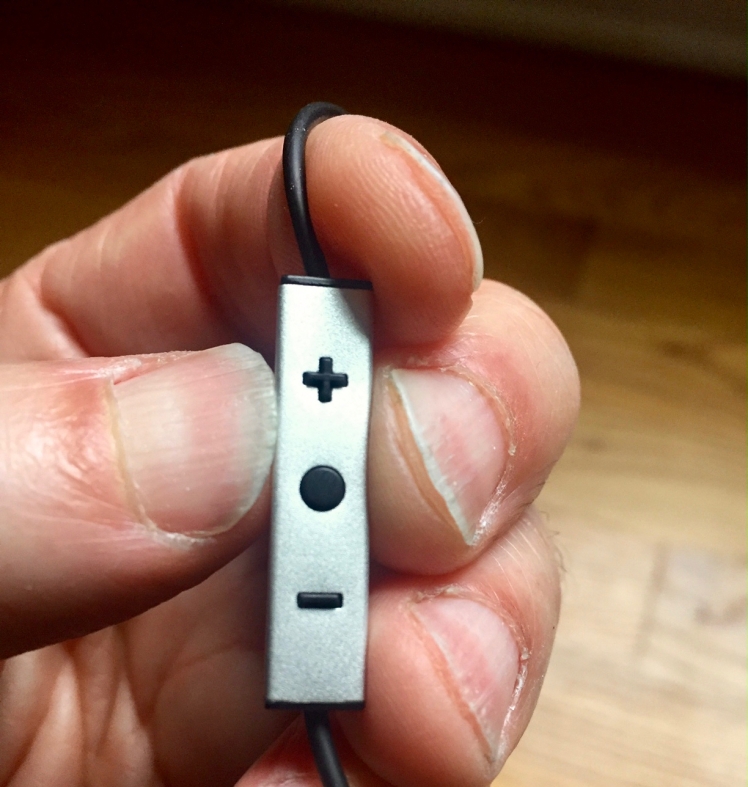
The M200’s include a nice microphone and remote control attached to the right channel cable. It’ll take your incoming calls and control an iPod or iPhone with volume, track skipping and play/pause.
Oh, and speaking of the cable, I’m happy to report that microphonics (the amplification of any rubbing between the cable and your clothing, etc.) is almost non-existent here. Hurrah!
Pros:
The M200’s have a balanced and superbly fatigue-free sonic signature. The upper end is smooth and even, without any trace of the upper-midrange spike that – while in many other earphones masquerading as “transparency” or “detail” – can easily render some inherently lively recordings, especially rock and hop-hop, painfully unlistenable. The M200 top end sounds extended and airy without being overly bright. The all-important midrange, where most of our music lives, including vocals, sounds just right to my ears, present but not overemphasized. The bass is slightly boosted, but so well controlled that there’s no muddying of the higher frequencies by an overzealous bass hump. In other words, rumbling, cavernous bass response is there when you need it, but it never feels phony or obnoxious.
As I’ve mentioned in other posts, one of my bass response test tracks is Steely Dan’s Negative Girl from their Two Against Nature CD. The M200’s are the only earphones I’ve yet auditioned (including several that sell for a great deal more money) that completely nail the very, very low notes played on a 5-string electric bass guitar in the opening bars of that jazzy track. It’s pretty thrilling to hear this done right. Also, all the synth bass grunt of Lorde’s Pure Heroine, especially on the hit track Royals, sounds as thunderous as it should.

Imaging with the M200’s is precise and the soundstage, if the material warrants it, is HUGE. To offer one familiar yet obscure example,

take Edwin Starr’s great, angry howl of a Vietnam era protest song, War:
During each chorus, someone’s totally killing it with some very flashy tambourine work in the right channel. On the M200’s, that tambourine is located way, way off to the right, clear as can be. It makes me grin.“War / Good God, y’all… / What is it good for? / Absolutely NOTHING!”
I could say a lot more about the M200’s sound, but I’ll simply repeat that there is zero fatigue factor with these lovely IEM’s. It’s trite to say so, but I can listen for hours and not tire of the sound.
Cons
Alas, nothing’s perfect. Here’s my list of caveats and (minor) disappointments:The M200’s come with a very sturdy zippered hard case (not pictured). It’s great for storage, but far too big to fit in a pocket or purse. I’d like to see something more pocket friendly included in the package.
Isolation from outside noise is, for whatever reason, only “okay,” even with a good seal. This isn’t a deal breaker for me, but it’s worth noting if, say, you regularly use your cans on noisy commuter trains and really need the ultimate in noise reduction.
Fit: I’m fine with the fit of the M200’s, but be aware that, at least from the reviews I’ve read, that’s not true for everyone. As I mentioned earlier, the diameter of the nozzle is unusually wide, and the use of the ear hooks takes some getting used to. Get a good seal with the ear canal and these will transport you to sonic bliss. Get a crappy seal and you ‘ll never hear what the M200’s can really do. Also as mentioned earlier, the Comply tips will make it easier to achieve a stable, slip-resistant fit, but at the possible expense of high end extension.
In Conclusion
I adore my M200’s. They make music come alive. They’re the closest thing I’ve heard to what I imagine it would be like to hang a pair of high-end home loudspeakers on both sides of my head. And considering how high the prices of the best IEM’s have climbed, they are a stone cold bargain at their US $200 asking price.But wait, there’s more:
ON SALE NOW!
From now through December 31, 2016, while supplies last, you can “steal” the M200’s for (drum roll…) US $69! Holy cow, folks, that’s the deal of a lifetime! I jumped on board and bought a second pair to have in case mine get lost or damaged. Here’s the sale pageat Kef America. Click now or lose out!That’s it for this review.
As always, be kind to others and enjoy your music!
groucho69
http://www.visions.ca/catalogue/category/Details.aspx?categoryId=0&productId=30306&sku=M200 EF Hi-Fi Dual Driver In-Ear Headphones (M200) With two dedicated dynamic drivers, M200 hi-fi earphones allow you to enjoy the most delicate nuances of the original recording.
Free Shipping!Sale Ends: 2016-12-31 $78.00
Free Shipping!Sale Ends: 2016-12-31 $78.00
rebbi
One review addendum:
“Driver flex:” this phenomenon – a clicking noise sometimes heard when you insert the tip into the ear canal – is caused by the dynamic driver flexing as air pressure equalizes. Some people find it annoying, and the M200’s sometimes exhibit this behavior on insertion. It doesn’t trouble me, but I thought I’d mention it.
“Driver flex:” this phenomenon – a clicking noise sometimes heard when you insert the tip into the ear canal – is caused by the dynamic driver flexing as air pressure equalizes. Some people find it annoying, and the M200’s sometimes exhibit this behavior on insertion. It doesn’t trouble me, but I thought I’d mention it.
groucho69
Still on sale at Visions
KEF Hi-Fi Dual Driver In-Ear Headphones (M200) With two dedicated dynamic drivers, M200 hi-fi earphones allow you to enjoy the most delicate nuances of the original recording.
Free Shipping!Sale Ends: 2017-01-05 $78.00 Save $172$249.99 ADD TO
KEF Hi-Fi Dual Driver In-Ear Headphones (M200) With two dedicated dynamic drivers, M200 hi-fi earphones allow you to enjoy the most delicate nuances of the original recording.
Free Shipping!Sale Ends: 2017-01-05 $78.00 Save $172$249.99 ADD TO
rebbi
100+ Head-Fier
Hey, folks: Here's my "tour" review of the Meze 12 Classics IEM's. It's cut and pasted from my audio blog. Feel free to comment here and/or there. Enjoy!
REVIEW: The Meze 12 Classics In Ear Monitors
Posted on November 25, 2016 by rebbi1Milestone
This review marks somewhat of a milestone for this blog. While I’ve written a bunch of reviews up to this point, they’ve all been for products that I’ve purchased with my own, hard-earned dollars.Then, a few months ago, I noticed on Head-fi.org that headphone manufacturer Meze Headphones was arranging a North American “tour” of their newest IEM, the 12 Classics. Those willing to write a review of the 12 Classics would receive a pair to evaluate. The reviewer would even get to keep the pair!
I was a little reluctant to sign on, fearful of the possibility of positive bias. Would getting “free stuff” make me more prone to write a review with a positive slant? Or, if I hated the 12 Classics, would I have the nerve to say so?
As you’ll see, all of this neurotic perseverating was for naught. The Meze 12 Classics are good, really good, and astonishingly good for the price.
Unboxing!
First the obligatory unboxing photos: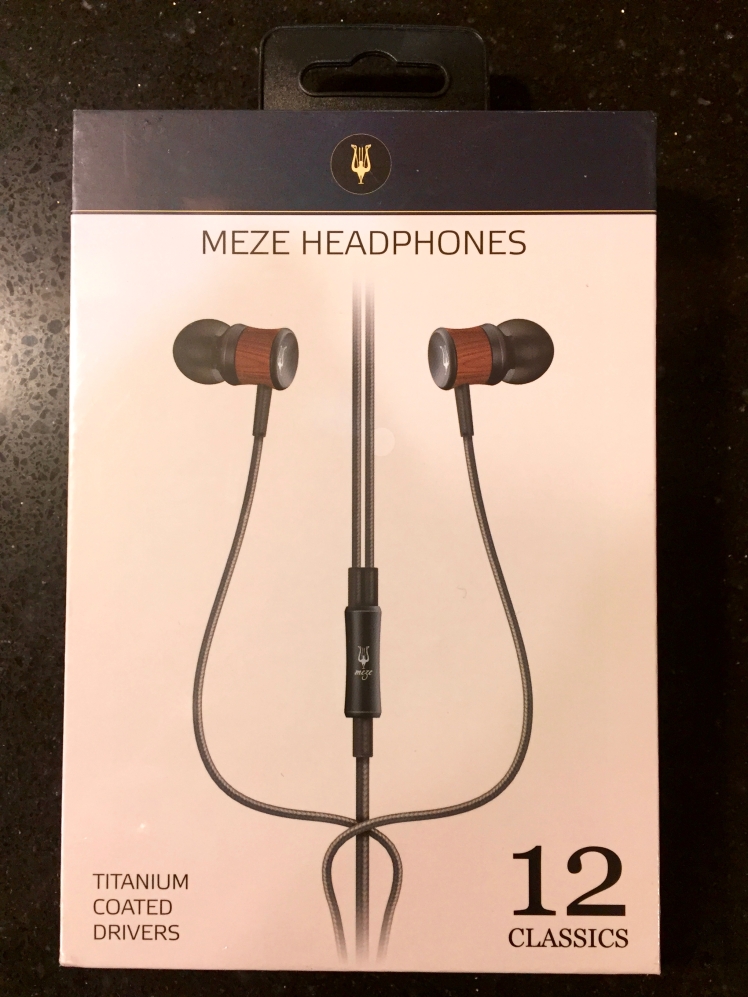
I like the no-nonsense packaging of the 12 Classics. There’s a hook at the top for a retail store sales rack, and a box not much larger than needed for the phones and accessories. I am not a huge fan of wasteful, “luxury” packaging, but that’s just me. Notice, though, how the arrangement of the cables on the front of the box mimics the “trident” Meze logo at the top of the box. Nice.
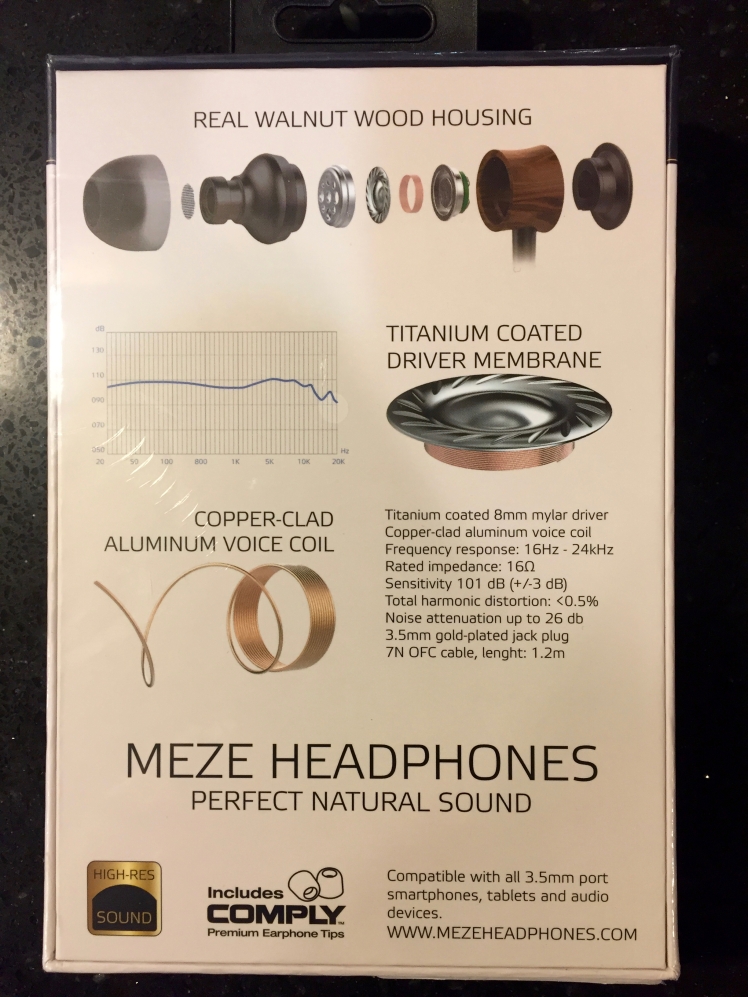
The back of the box gives some nice technical information on the 12 Classics, along with the exploded view of its innards.
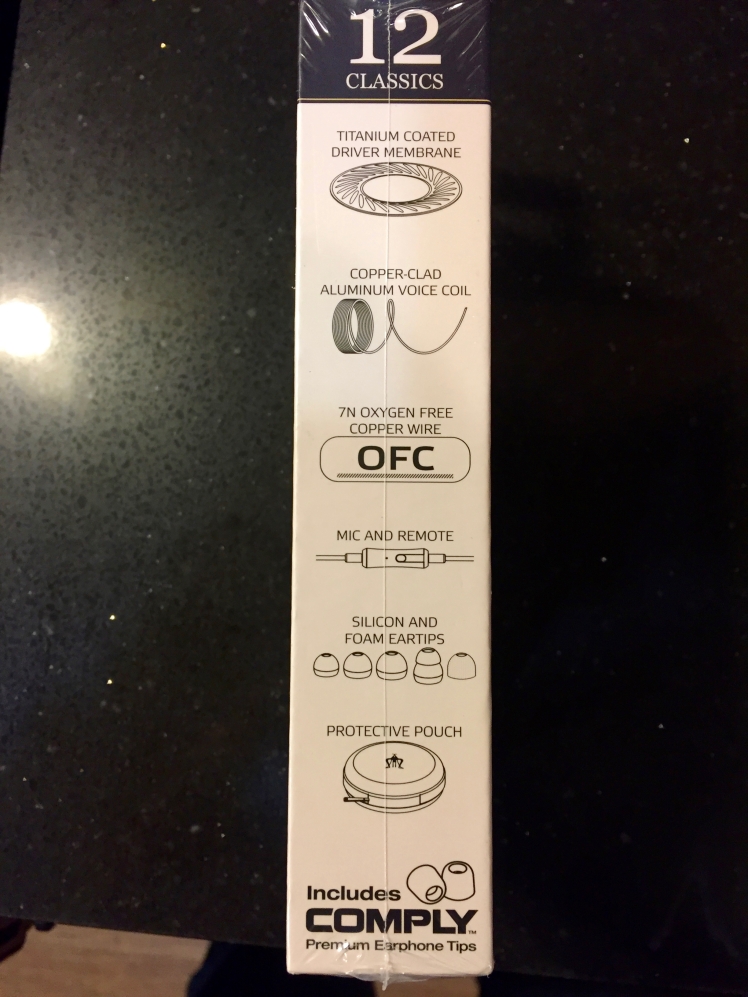
One side panel of the box.
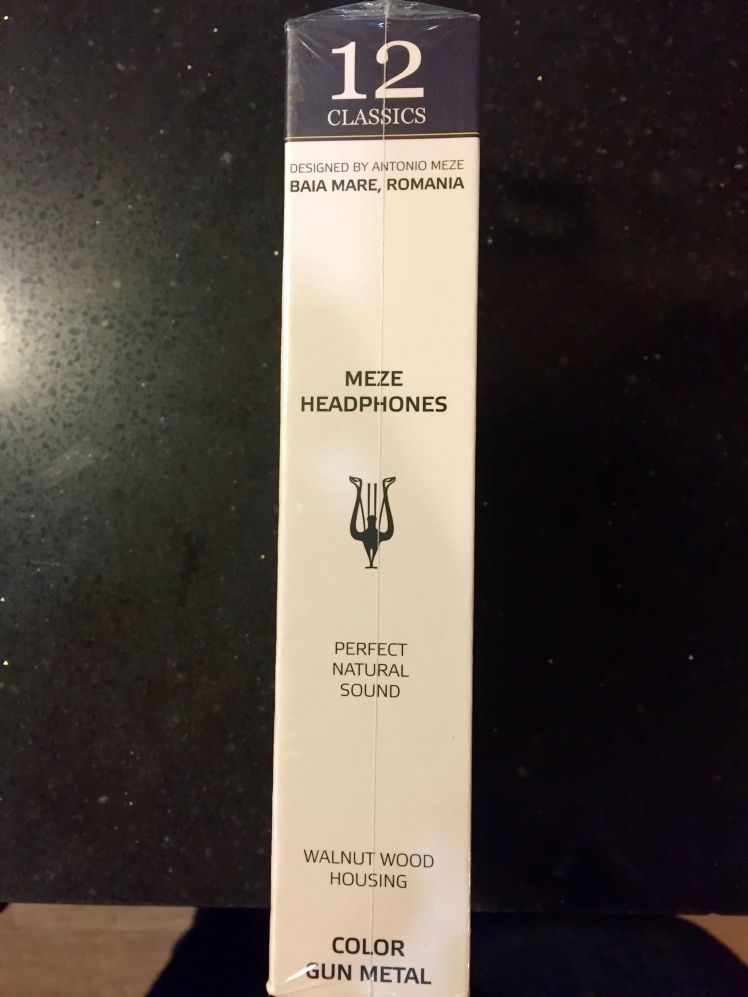
And the other side of the box.
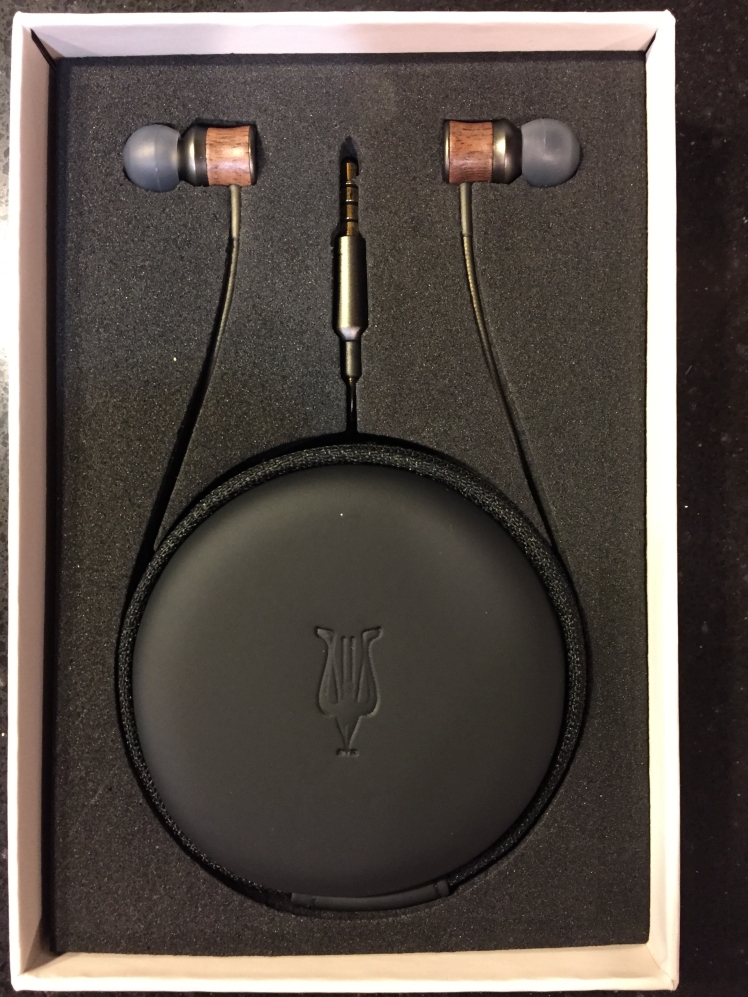
The inside is a refreshingly simple, functional affair, with the foam insert holding the earphones and the nicely embossed carrying case.
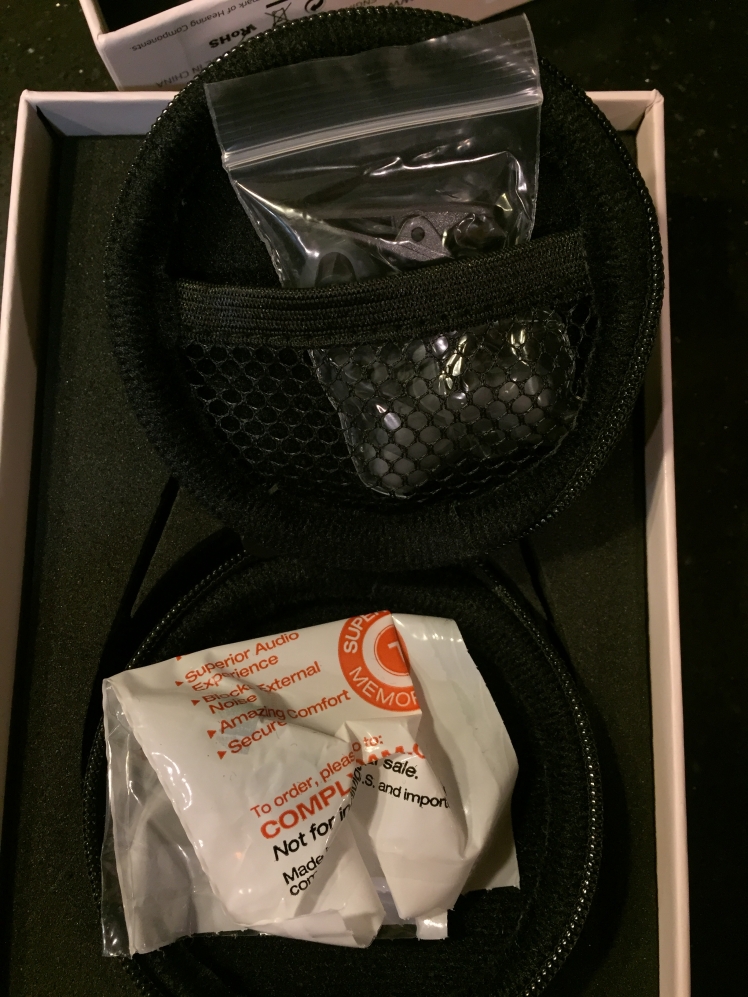
Here are the contents of the carrying case. You get one pair of Comply foam tips, along with a plastic bag containing…
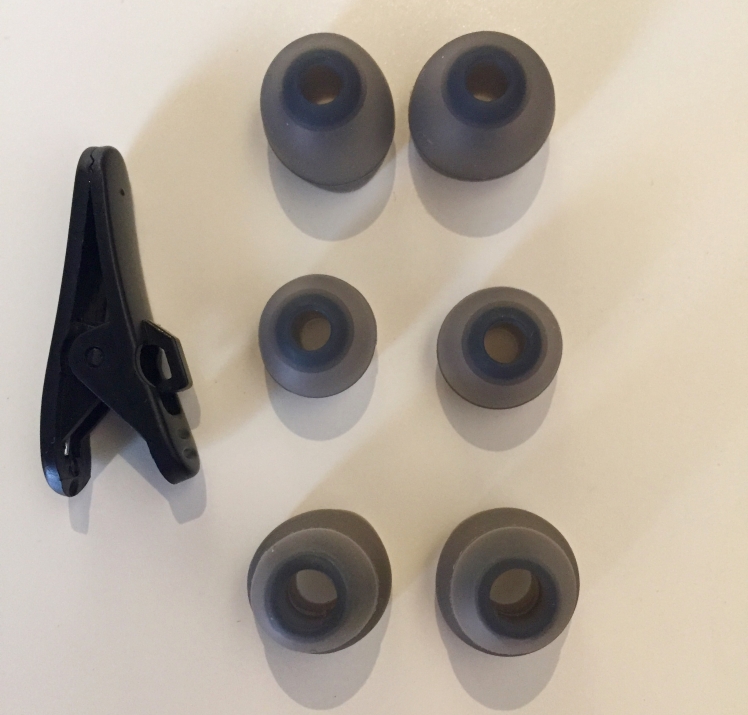
…several pairs of silicon tips, including a dual-flange design, along with a cable shirt clip.
Design and Materials
Before we get to the most important part of this review – how the 12 Classics sound, of course – I want to comment on their physical design.At any price, but especially at their “bargain” price of US $79, the 12 Classics are an exceptionally beautiful product. Take at look at this side view of the housings:
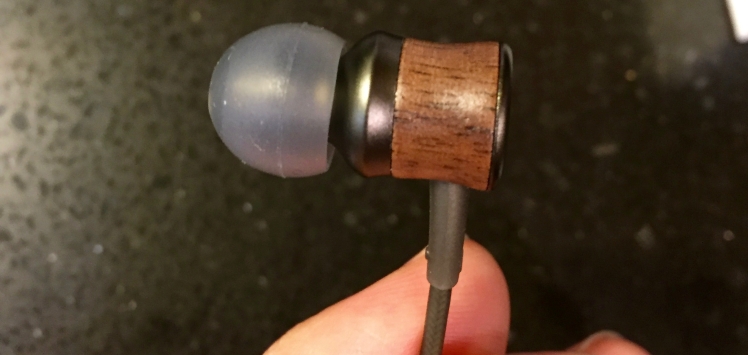
The walnut body of the earphone housing looks great, especially offset by the gunmetal grey aluminum end caps. Notice, too, the slight hourglass taper of the wood portion of the housing. This design note, the “hourglass” or concave surface, appears repeatedly throughout the design:
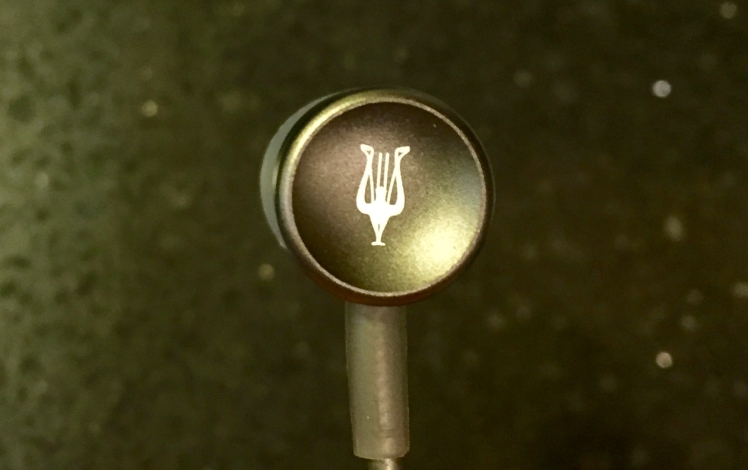
In the concave, outer surface of the end cap, decorated with the Meze logo.
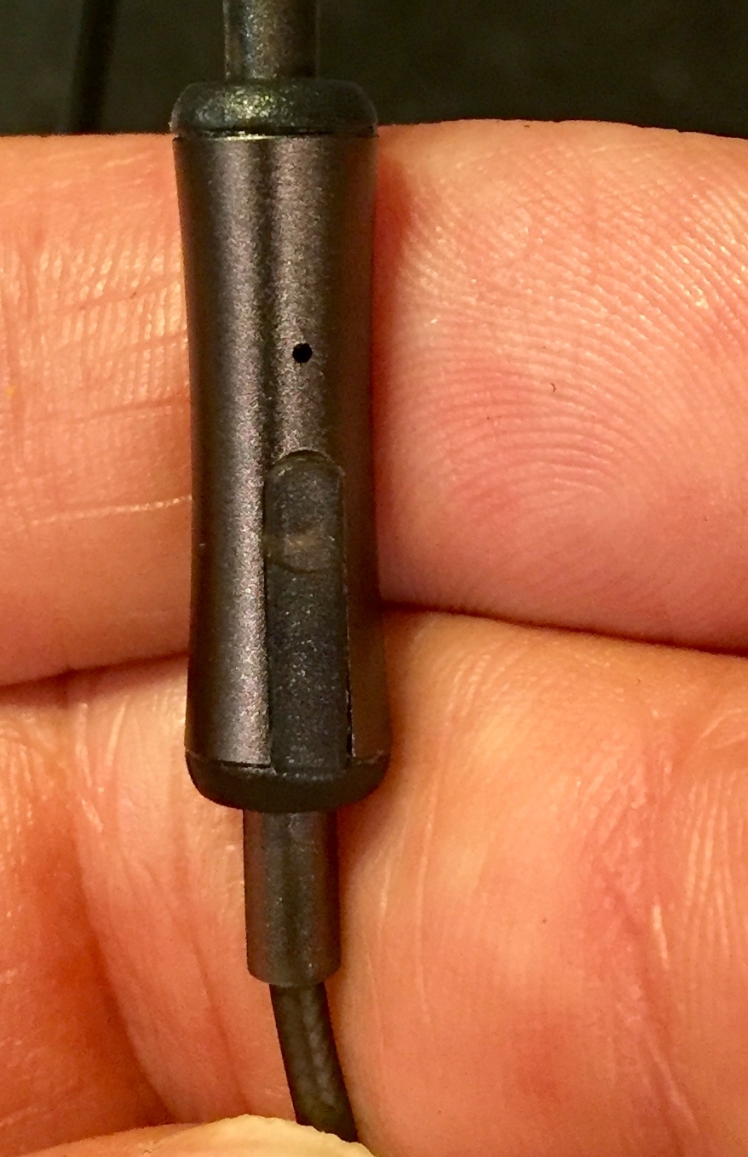
In the subtle, hourglass shape of the mic/remote housing.
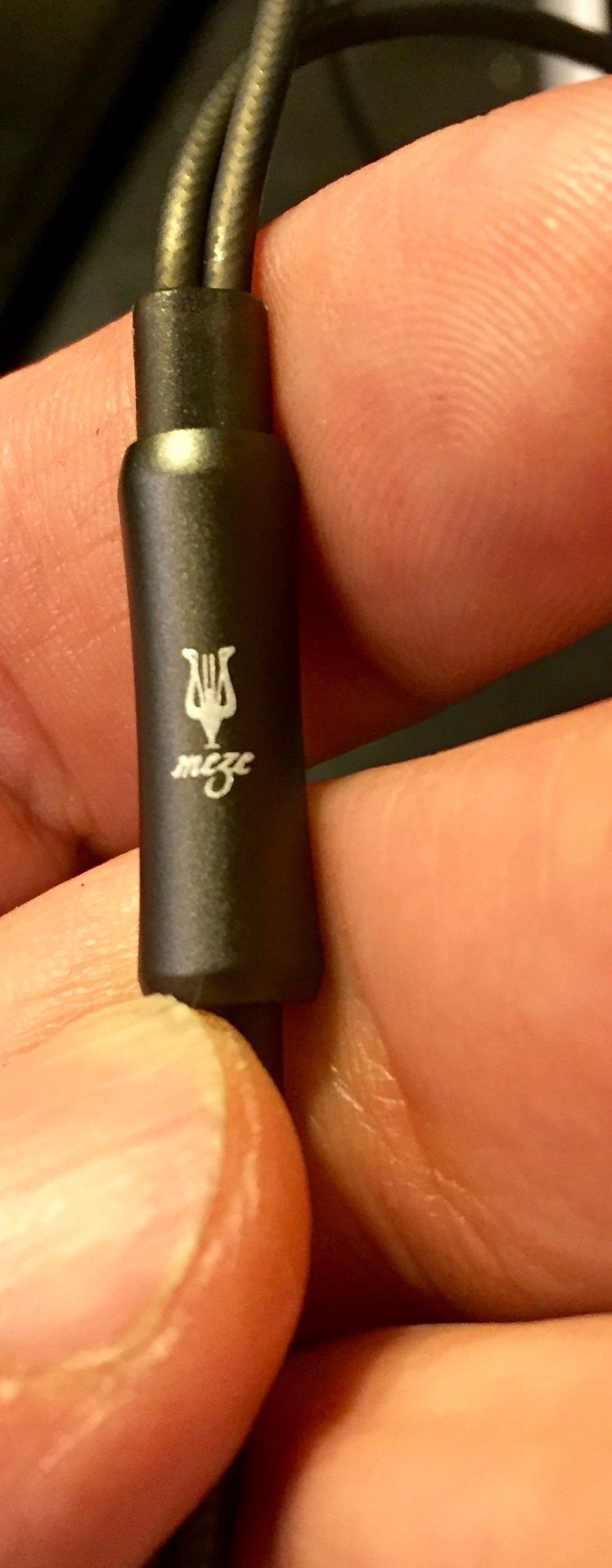
And in the concave, hourglass shape of the Y-splitter.
Additionally, the color of the cable jacket provides a beautiful match to the metal of the housings. A shout out, too, should be given to the tiny, light housings. I can’t imagine that anyone would find these IEM’s uncomfortable. They are definitely in the “you can forget you’re wearing them” category. Note, however, that these can’t be worn with the cable looped back over the top of your ear – they just don’t work that way.
Now, normally, I wouldn’t devote this much time and attention to the physical form of a pair of IEM’s. In this case, though, the consistently elegant design of these earphones tells you that someone took a lot of time and care designing the exterior of these things, suggesting that they might have taken equal care in their sonic design, too. So, is that the case?
A Digression and an Analogy: The Driver Wars
The Meze 12 Classics feature one driver per side: a proprietary, titanium-coated-mylar diaphragm, dynamic (as opposed to balanced armature or planar magnetic) driver, a tiny 8 mm in diameter.That’s it? Just one driver per side, when so many IEM’s these days tout two or more drivers in each earpiece? Ah, you might think – no wonder they’re so inexpensive. Just one driver!
Not so fast.
Do you remember the “megapixel wars?” In the early days of digital photography (and still, today, to some extent) digital camera manufacturers did a lot to promulgate the meme that the number of pixels crammed into a camera’s sensor chip determined the quality of the images the camera could produce. In other words, the more pixels, the better. Over time this proved not to be true. In fact, the only sure advantage of more pixels was that a higher-resolution photo could be cropped and enlarged without becoming pixellated. On the other hand, it turned out that squeezing ever more pixels into tiny sensor chips often resulted in images with more graininess, digital “noise” and chromatic aberration (purple “fringing” around high-contrast areas of a photo). Gradually, savvy consumers learned that many other factors besides how dense the pixels were on the CCD chip( such as the quality of the camera’s lens) influenced the image quality one could expect. My aging but still excellent Nikon D50 DSLR, for example, is “only” 6 megapixels, but the image quality is still wonderful.
Yikes!
Why the heck am I talking about digital cameras in an audio blog? Because the IEM equivalent of the megapixel wars seems to be the Driver Wars, a marketing proposition that suggests that the more drivers that a manufacturer has managed to cram into an IEM’s housing, the better it must sound. The result is that at both the very expensive high end (such as this six-balanced-armature driver-per-side custom IEM by JH Audio) or in more mid-priced territory (such as this “bargain priced,” 7-driver-per-side Chinese IEM) many shoppers assume that the number of drivers per earpiece is directly proportional to the sonic goodness of the IEM.
To quote the great George Gershwin, “It ain’t necessarily so.”
Consider home audio. The engineering challenge of integrating multiple drivers in home stereo loudspeakers is well documented. Using a complex, electronic crossover to dissect and distribute a musical waveform amongst several different drivers, each covering a different part of the frequency range, and then attempting to faithfully reconstitute that musical signal at the ears of the listener, is notoriously difficult. Most crossovers introduce phase and time distortions into the music that can make the music sound less coherent, less cut from the same cloth.
That’s why there a whole home audio subculture devoted to single-driver speakers, which can exhibit an uncanny musical “rightness,” especially in the midrange where most music (vocals especially) lives. And yet, there’s no free lunch in physics, and so, to quote from this old blog post of mine:
So, does the presence of more than one driver automatically equal better sound? No way. There are simply too many other variables (such as driver type and design, housing design and materials, crossover design and more) to make that kind of generalization. Thus I have purchased (and subsequently returned) several well reviewed, multiple driver IEM’s that I thought sounded dreadful (all boom and sizzle, so to speak) and I’ve heard several single driver designs that I loved. In the end, the number of drivers tells you very little about the musical goodness of an IEM. You just have to listen for yourself!In the field of high sensitivity loudspeakers, a particularly interesting segment is populated by single-driver designs. This means just what it sounds like it should mean: single driver speakers use one driver to cover the entire frequency range. These drivers typically have very, very light speaker cones and powerful motor magnets. Why bother trying to make a single driver cover the entire audio spectrum? For one thing, a single drive speaker needs no electronic crossover network to divide up the frequency spectrum among specialized woofers, midranges and tweeters. This avoids all sorts of potential nastiness, including phase anomalies and the tendency of complex crossovers to suck power (which is one reason that single-driver speakers tend to be rather [low power amp] friendly). Also, providing a true “point source,” single driver speakers are cherished for their otherworldly imaging prowess. On the downside, single driver designs are often faulted (by those who don’t care for them) for having limited bass response, limited dynamic range and the tendency to produce harsh or “shouty” treble…
Which, at last, brings us to…
The Sound Of The Single-Dynamic-Driver Meze 12 Classics
I guess I should note here that I did all my evaluative listening with my iBasso DX80 DAP. I gave them about 24 hours of break-in before doing any serious listening. All files referenced below are lossless CD rips or high-resolution commercial downloads. That said,The 12 Classics do something important (to me) that you’d hope a well designed and executed pair of single-driver IEM’s would do: they nail coherence. Music flows easily, sounds like a performance (and not just “sound”) and allows you to relax because your brain isn’t working overtime to decipher what you’re hearing. They render the aural cues that we interpret as ambient space with uncanny nuance, and their ability to place musical elements (singers, instrumentalists) on an almost visual sound stage is very strong. You can really hear this facility with spatial presentation on well recorded, live recordings like Chan Chan from the magnificent Buena Vista Social Club. The sense “air” and space around the voices of the magnificent Ibrahim Ferrer and Eliades Ochoa as they joyfully rip into this slow number is just gorgeous.I love the Meze 12 Classics. Without regard to price, they are a very lovable, listenable, coherent and musically satisfying pair of IEM’s. Factoring in their sub-$100 retail price, they are an astonishing bargain.

The same goes for the placement and separation of the background singers in Traffic Jam on James Taylor’s (Live) double CD set. It’s quite thrilling.

The 12 Classics also do a great job with tonality: a sax sounds like a sax, a voice sounds like a voice, an orchestral string section sounds woody and sweet and a guitar sounds like a guitar.

The frequency extension of the 12 Classics is remarkable, especially considering that they’ve chosen to go the single driver route. The low end, while not exhibiting the ultimate in tightly controlled bass, goes quite deep, with plenty of grunt and rumble when called for. My favorite “bass test” track is Negative Girl from Steely Dan’s Two Against Nature CD. The opening ten or so bars of that tune feature some tasty lines played on a five-string electric bass guitar, with some extremely low notes. It’s quite impressive how well the 12 Classics render those very low bass notes!

This facility with lower frequencies also does great things with percussion. For example, I was stunned with what the 12 Classics did in rendering the deep, yet tuneful THUD of the huge drumbeat that opens Hotel California on The Eagles Hell Freezes Overlive CD. And again, they do this all with a single, carefully tuned and executed dynamic driver.

At the high end, the 12 Classics feel extended, but without the upper-midrange spike (masquerading as “detail”) that can make some IEM’s painful to listen to. My “test track” for this is Lorde’s Buzzcut Season from her Pure Heroine album. The vocals are very closely miked and Lorde’s voice is definitely EQ’ed with an upward tilt. The test comes near the beginning of this (wonderful) song, when she sings,
Lesser earphones with a “fake detail spike” will render the sibilants in “kissed,” “scalp” and “caressed” as virtual icepicks to your eardrums. Ugh! The 12 Classics get this just right: “hot” but not abrasive. I’ve listened to $300 IEM’s that couldn’t get this right.I remember when your head caught flame
It kissed your scalp and caressed your brain
Midrange, too, where most of our music lives, is excellent. Vocals sound great – warm, human and alive.
What’s Not To Like?
Alas, nothing’s perfect. Here are a few areas where I think the 12 Classics fall short:- The cable is markedly microphonic. The texture of the insulation has a somewhat rubbery quality, which bodes well for long term durability but seems to have a role in increasing friction and thus transmitting and amplifying any noise generated by the cable rubbing against your clothing. The included cable clip should help with this, but I wish it weren’t that necessary.
- The L and R channel markings on the housings are nearly invisible. They are embossed on the outside of the light grey strain relief tube underneath each earpiece and are very hard to discern. This problem is mitigated by the fact that once you realize that the microphone is attached below the right channel earpiece, the need for R and L markings is not as great. Still, in a product this thoughtfully designed, it’s a bit of a surprise.
- The selection of ear tip sizes could be a little more varied. I have pretty large ear canals and the only tips that give me a good seal are the largest silicone tips. Both the Comply foams and the dual flange tips don’t cut it for my aural anatomy. Hardly a deal breaker, especially at this price, but something to be aware of.
- Soundstage width: I’m still pondering this one. It’s quite good, actually, but not as cavernous as I’ve experienced with some other IEM’s, such as my KEF M200’s (which, to be fair, retail for more than twice the price of the 12 Classics). But truthfully this is only a relative “minus” in comparison to some other IEM’s I’ve heard that are soundstage width champs. And at this price, it’s hard to complain.
In Conclusion
I said it before and I’ll say it again. I love the Meze 12 Classics. Without regard to price, they are a very lovable, listenable (for hours on end without fatigue) coherent and musically satisfying pair of IEM’s. Factoring in their sub-$100 retail price, they are an astonishing bargain.Highly recommended!
As always, I love it when my readers comment on a post, so feel free to do so. Until next time, be kind to others and enjoy your music!
rebbi
100+ Head-Fier
Pros: Uncolored, airy, full-bodied, audiophile sound. Detailed without being obnoxiously bright.
Cons: Not the world's best choice for driving low-sensitivity, full size cans. Current 1.5.8 firmware is nearly bug-free but could still use a tweak or two.
[size=17.03px]Introduction: Unfamiliar Territory[/size]
A couple of years ago, I was telling my father-in-law about my audio and music hobby. He asked me if the equipment I had was made by "Pioneer, Sony" or another well known brand. I explained that those were, generally speaking, mass-market brands, and that the equipment favored by hard-core audiophiles these days was often made by "boutique" or specialty brands with names like Wilson, ProAc, Audio Note or Primaluna (I didn't even mention Schiit!) - names well known in the audio community but unheard of in the larger, consumer electronics markets.
The more deeply I've ventured into the world of high-end, portable audio, the more I've come to understand how my father-in-law felt while I rattled off the names of obscure brands of audio equipment he'd never heard of.
It's true that the home audio speakers-and-amp enthusiast will encounter some more familiar names when venturing into this corner of the hobby: Sennheiser, AKG and Grado, among others, make some well respected headphones. Oppo, revered for their universal DVD and audio disc players, makes some portable gear like headphone amps. And lately, even familiar, home hi-fi brands like the venerable, value-oriented NAD and the very high-end, French manufacturer, Focal have gotten into the portable market.
But... hang out long enough on Head-fi.org and you'll enter a market also populated by small brands you (the home audio enthusiast) have never heard of; names like Dunu, Final Audio Design, Fidue, Campfire Audio, Dita, and (the subject of this review) iBasso.
The iBasso DX80 Digital Audio Player
You can check out this post to see why I decided to go with a stand-alone DAP rather than an iPhone with an external DAC/amplifier. Having now lived with my iBasso DX80 for about five months, I'm glad I did. I have found the all-in-one, special purpose DAP to be a convenient way to get high-end sound on the go, without having to plug another piece of hardware into my cell phone in order to accomplish the same thing.I selected the iBasso DX80 after doing my research on the Internet in general and on Head-fi.org in particular. With dual Cirrus 4398 DAC chips (one per channel), a (mostly) metal body, a largish touch screen, three physical navigation buttons (which I love - more on that in a bit), dual MicroSD card slots supporting (theoretically) up to 2 terabytes of storage, the ability to function as an external DAC for your laptop, and more - and all of this at a current street price of just over US $300 - the value proposition on this unit seemed very high.
Unboxing Photos!
At first I wasn't going to bother including my own unboxing photos of the DX80 since they're available all over Head-fi. Yet I know that you, my beloved readers, love them, so here we go...
Here's the outer box of the DX80.
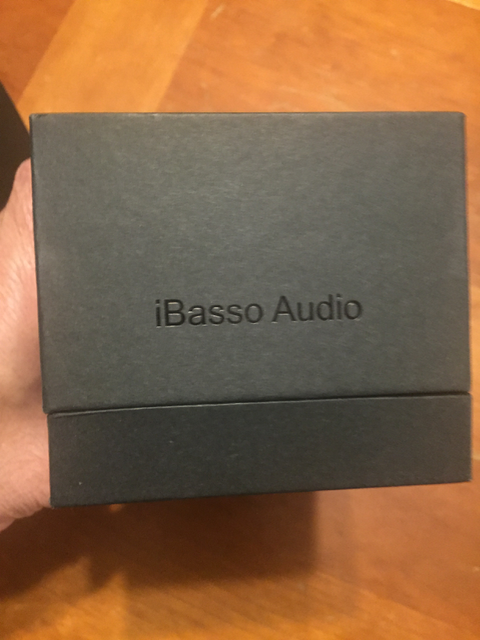
... and from the top.

The retail box is kind of a clamshell affair. (Note that in this picture I've already installed one of the included screen protectors.)
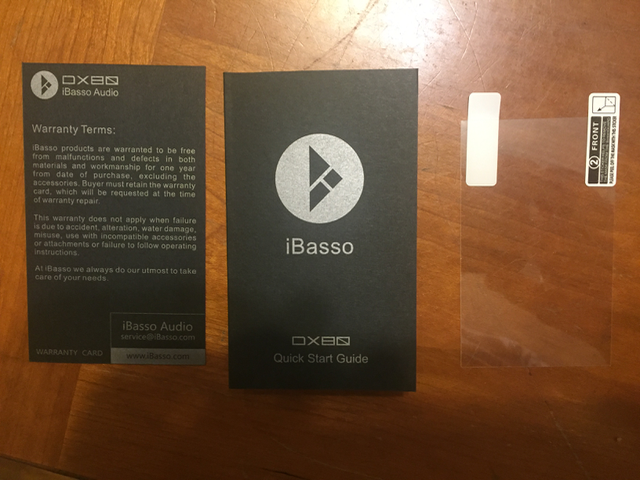
There is a wedge-shaped box of accessories packed under the main unit. Here we see the warranty card, Quick Start Guide and one of the two supplied screen protectors.
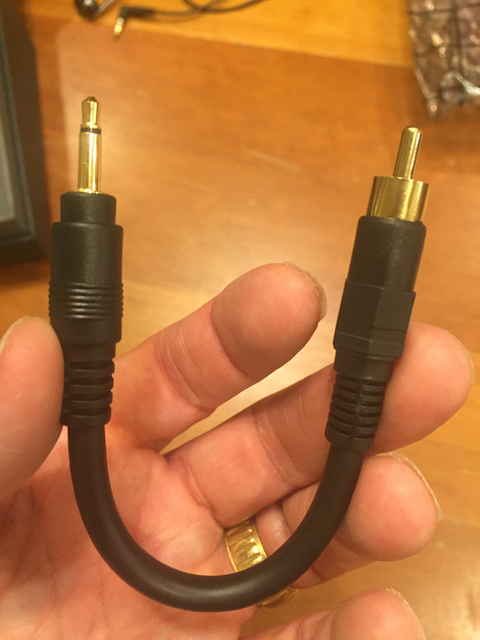
Here's the mini-plug to coaxial cable, for taking a digital (SPDIF) signal out of the DX80 and feeding it to an external DAC.

A reassuringly beefy USB to micro-USB cable, used for charging, transferring music files and employing the DX80 as an external DAC with a laptop or other computer.
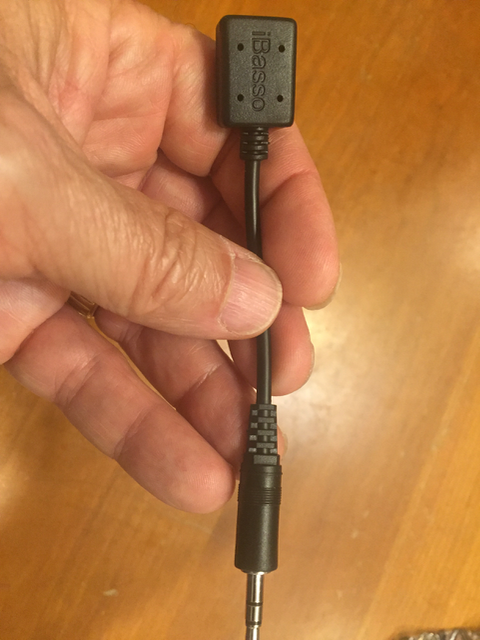
Some people believe in the need for audio gear to be "burned in" to in order to reach its full sonic potential. Others do not. Clearly, iBasso does, which is why they supply this nifty burn-in cable. It provides a resistive load to mimic a pair of earphones. Plug it in to the headphone jack, set a playlist or album on "repeat" and it will allow you to silently burn in the DX80 without abusing your favorite ear phones.

iBasso also thoughtfully includes a silicone rubber case for the DX80. Although, like all such cases, it's a bit of a dust magnet, its grippy texture helps prevent drops and its springy consistency provides some nice impact protection. The Korean company Dignis also makes a leather case for the DX80.
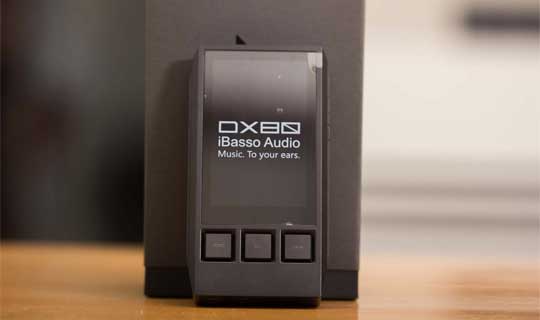
Shamelessly stolen from another web site, here's a photo of the DX80, naked except for its retail screen protector.
User Experience: Touch Screen Interface
As is the case with a lot of Chinese brand digital audio players, the DX80 uses a customized version of Android for its operating system and touch screen user interface.This seems like a good time to report that iBasso has been quite diligent about pushing out regular firmware updates for the DX80. (Here is the download page where you can find firmware update files for various iBasso products.) Updating the DX80 firmware is a fairly trivial procedure – download and expand the file, which will be called "update.IMG." Make sure the file is located in the root directory of the microSD card in Slot #2 and either choose Update Firmware from the Advanced menu or reboot holding down the power and Volume Up buttons to get you into an early start up menu that will give you the option to update the firmware. At this point, as of firmware version 1.5.8, the DX80 firmware is quite solid, with just one, minor bug* remaining, but, for my purposes, no showstoppers.
Let's take a look at the user interface.
There are two ways to interact with your DX80.
The first is by using the touchscreen. You can tap the touchscreen to select tracks. You can also swipe left from the currently playing song to access the My Music screen, or swipe right to access the Settings screen. Here's a visual tour of the touchscreen interface:

This is the Now Playing screen. The navigation widgets and scrubber bar are pretty self explanatory. Notice, too, the little icon on the right above the scrubber bar, indicating that the entire album should repeat. Tapping there will give you several other repeat options. As shown here, a single tap on the album art brings up the Volume and Battery charge display overlaying the top of the album art....
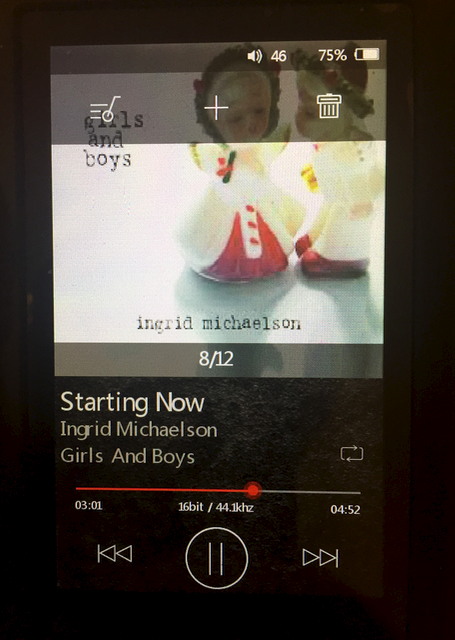
... and a second tap reveals icons that (from left to right) when tapped will display (from left to right) Song Info (size, format, bitrate, etc.), add the current song to a Playlist and remove the song from a Playlist.
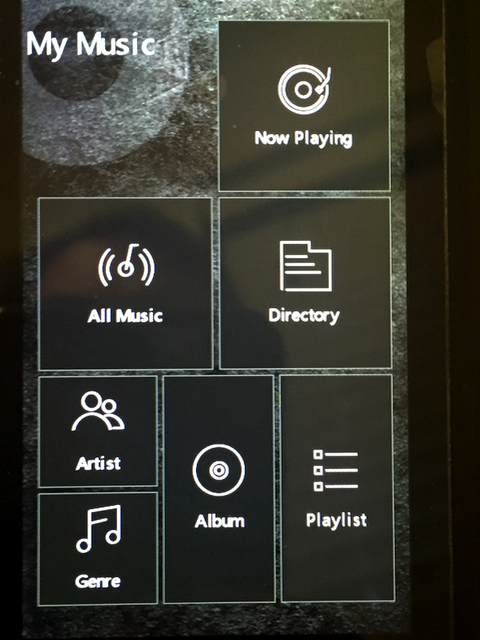
Swiping across the Now Playing screen from left to right gets you to the My Music screen, showing all the ways you can organize and access your music collection. I find myself using Album view most often.

The Album view, list mode. Tap the icon in the upper right margin and you can see your albums like this...

Album mode, thumbnail view!
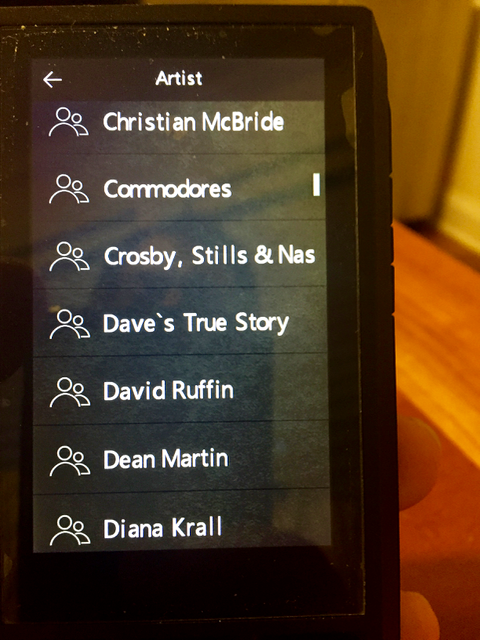
Here we see Artist view...
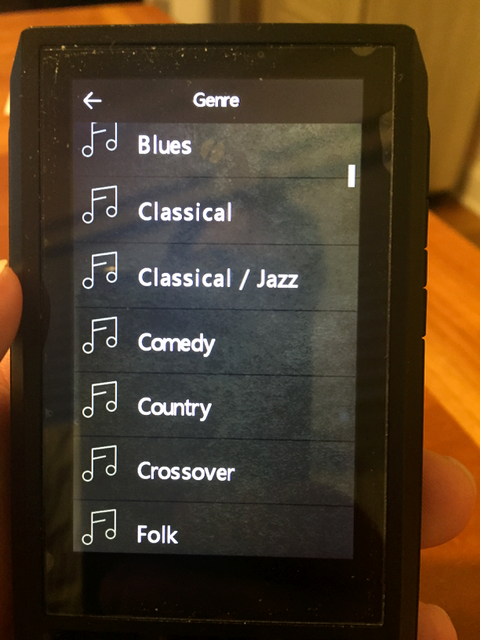
... and the Genre view.

Swiping right to left from the Now Playing screen takes you to this Preferences screen.

Here are the Advanced Options, where you can set things like display brightness and time until the DX80 automatically powers off. Rescan Library merits its own screen shot...
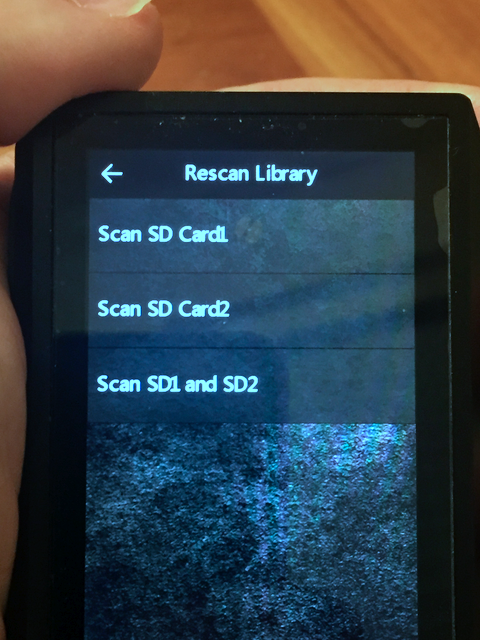
Whenever you've added new music files to either of your Micro SD cards, you'll want to rescan that card with this screen. This rebuilds the index of all your files so that the DX80 can access them by their various metadata (album, artist, genre and so on).
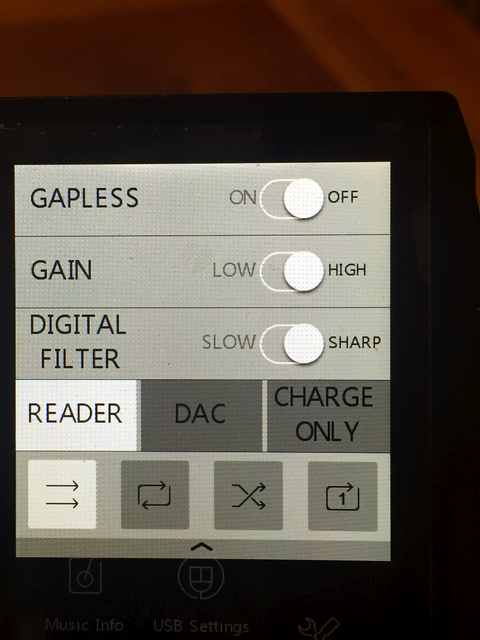
Finally, a downward swipe from almost any screen brings you this handy-dandy shortcut to the most frequently used Advanced Settings. Gapless Playback should be enabled for albums (e.g., live concert recordings) meant to be played with no pause between tracks. The Gain setting can be set to either high or low, depending on the sensitivity of your 'phones (with the caveat that High Gain mode will tend to drain the DX80 battery more quickly). Low Gain works fine for most IEM's, but if you're driving a pair of less sensitive, full-size "cans," High Gain may be your better choice. The Digital Filter setting is supposed to shape the way your files sound, but honestly, I haven't found it to make that much of a difference. The next row of buttons toggles that way the DX80 behaves when plugged into a computer's USB port. (Reader mode mounts the DX80's memory as a removable volume on your computer, allowing you to transfer files to the DX80. DAC mode allows the DX80 to function as an external DAC for your computer - very handy!) And in the bottom row, you can set the playback repeat mode.
User Experience: Buttons!

For all of the power and flexibility of the touch screen controls, my favorite UI feature of the DX80 consists of three large, physical buttons just below the screen; from left to right, as expected, we have Skip Backward, Play/Pause and Skip Forward. (Additionally, a long press on these buttons will Skim Backward in the current track, Lock The Screen And Buttons, and Skim Forward in the current track, respectively.) This means that you can control many of the DX80's playback functions without having to look at the touchscreen. You'll deeply appreciate this when listening to music in the dark at bedtime or when you want to control the unit without removing it from your pocket. Add to this the physical volume increase and decrease buttons on the right side of the DX80 and you get a lot of everyday control without having to actually look at the unit. This is brilliant, and deeply appreciated, especially compared to listening to music on today's smartphones that require you to deal with the touchscreen to do almost anything except adjust the volume.
The Sound
I find the sound of the DX80 to be quite lovely: airy, neutral and uncolored, which in my book is a good thing. You get the sound of your music files without a lot of editorializing, although, of course, you can use the built in graphic equalizer screen to tailor the sound to suit your tastes if you like. I tend not to "EQ" my music - probably a silly holdover from my home audiophile snobbery - but others love to equalize their music.This "neutral-ish" assessment of the sonic character of the DX80 comes with two caveats.
First, the only other portable, digital players I've ever spent significant time with over the years were a first-generation (!!) iPod and a series of iPhones, so my DAP listening experience isn't as broad and varied as some.
Second, like your feelings about any portable music player, your perception of the DX80's sonics will be VERY significantly influenced by the headphones or earphones with which they are paired. With a pair of Sennheiser IE80's, I found the sound to be overwhelmingly bloated and bass-heavy (for my tastes, of course). With the Dunu DN-2000j and the Musicmaker Shockwave III, the highs were (to my treble-sensitive ears) punishingly bright on pop music with a more compressed, "modern" sound signature, such as Lorde's Pure Herione. But paired with the Final Audio Design Heaven VII, the Hifiman RE-600 "Songbird" or (especially!) the luscious KEF M200 IEM's, the sound is just beautiful and supremely musical. To my surprise, I have found that, paired with the right earphones, the iBasso DX80 can deliver a musical experience that's extremely immersive and emotionally satisfying. It's different than listening to my full-size home stereo rig, but no less enjoyable in its own, unique way. And I can take it with me wherever I go!
By the way, iBasso has a new, "statement" model in the works, to be called the DX200. Hopefully I'll get my hands on one when it's released so I can share how it stacks up compared to the DX80.I'll have a lot more to say about my IEM travels in my next blog post! But for now, I'd highly recommend the iBasso DX80 to anyone looking for a standalone Digital Audio Player. It's well built, well priced, works almost perfectly and sounds great.
Until next time, be kind to others and enjoy your music!
*"one minor bug" - Under the current 1.5.8 firmware, if you power off (automatically or by hand) the DX80 while listening to an album, when powered back on, the tracks will be in alphabetical order rather than album order. Annoying, but a couple of screen taps gets you back to album sort order. As far as I can tell, this is the sole remaining DX80 firmware bug.
Hey, folks, hope you enjoyed this review. It's also available, in a somewhat prettier form, on my audio blog, here.
hqssui
Nice review. Thanks
zombicube
Nice. You remind me, though, that while I love love love the physical buttons, I wish that the middle button had any sort of texture to it--grooves, a few braille dots, anything--because I am absolutely terrible about accidentally pressing the wrong button. Having one of the three (middle makes the most sense) give a different tactile feel would mean I never press the wrong one when the player is in my pocket. I would also do this with either the up or down volume button, since I also often find myself ineffectually turning the screen on/off in my pocket when I intend to be boosting/reducing the volume.
rebbi
100+ Head-Fier
Pros: Tiny size, comfortable fit, great selection of tips, beautifully, detailed, smooth and balanced, neutral sound, zero fatigue factor.
Cons: Miserable, non-replaceable cable that inevitably kinks and shorts out.
I have been a home audio buff and proud audiophile snob
 for decades and have only really gotten back into portable audio gear in recent months. I was looking for a nice pair of audiophile IEM's to replace - on a limited budget - my failing, seven year old Etymotic ER-4P's. I value tonal accuracy and sound-staging, and while I want bass to be present I am not a "bass-head." Oh, and I cannot stand upper-register sibilance and harshness masquerading as "detail."
for decades and have only really gotten back into portable audio gear in recent months. I was looking for a nice pair of audiophile IEM's to replace - on a limited budget - my failing, seven year old Etymotic ER-4P's. I value tonal accuracy and sound-staging, and while I want bass to be present I am not a "bass-head." Oh, and I cannot stand upper-register sibilance and harshness masquerading as "detail."
So, now you know my biases!

After doing lots of research on Head-fi, I ordered a pair of RE-600's on Amazon.com.
Sonically, I was beyond thrilled with them! They "play it right down the middle" as one reviewer put it, with a neutral yet compelling tonal signature and a way with human voices which is positively enchanting. This is one of those "I could listen for hours" 'phones. Wonderful!
Beyond that, the housings are well made and feather light. They are tiny and inconspicuous and a pleasure to wear.
I believe that the RE-600 might have actually been my end-game IEM's, if not for the fact that the lower, cloth-covered cable is incredibly fragile and prone to shorting out. In the process of coiling and uncoiling the cable (that is, taking it out of and putting it into the lovely little zipper case) the cable will develop kinks that cannot be smoothed out. Eventually, one of these kinks will turn into a short that will get worse and worse until the phones are unusable.
Lest you think this is my one-off experience, go to the RE-600 Impressions thread and skip to the most recent 8 or 10 pages, and you will read the complaints of multiple, outraged owners of shorted out RE-600's.
The nice lady who answers the phone at USA Hifiman customer service in New Jersey was unfailingly pleasant and sent me a warranty replacement pair in a reasonable amount of time, but as other owners in the above thread have noted, that's all the company will do. They won't acknowledge the problem and (maddeningly) continue to sell this failure prone "flagship" product at a not-inexpensive price. I ended up selling my replacement pair at a bargain price while making sure the buyer knew what tended to happen to these IEM's.
I'll only add that I review home audio gear on my Audio Blog and have never written a review quite this negative. I only want to spare readers of this review the kind of frustration and disappointment that I and so many others have experienced. I can only hope that Hifiman will get its act together and upgrade this wonderful sounding IEM with a decent and durable cable. I'd buy one in an instant if they did. But as things now stand, I'm avoiding their products, even their prized headphones, because I don't think their behavior vis a vis the RE-600 should be rewarded.
Hope this helps someone!

So, now you know my biases!

After doing lots of research on Head-fi, I ordered a pair of RE-600's on Amazon.com.
Sonically, I was beyond thrilled with them! They "play it right down the middle" as one reviewer put it, with a neutral yet compelling tonal signature and a way with human voices which is positively enchanting. This is one of those "I could listen for hours" 'phones. Wonderful!
Beyond that, the housings are well made and feather light. They are tiny and inconspicuous and a pleasure to wear.
I believe that the RE-600 might have actually been my end-game IEM's, if not for the fact that the lower, cloth-covered cable is incredibly fragile and prone to shorting out. In the process of coiling and uncoiling the cable (that is, taking it out of and putting it into the lovely little zipper case) the cable will develop kinks that cannot be smoothed out. Eventually, one of these kinks will turn into a short that will get worse and worse until the phones are unusable.
Lest you think this is my one-off experience, go to the RE-600 Impressions thread and skip to the most recent 8 or 10 pages, and you will read the complaints of multiple, outraged owners of shorted out RE-600's.
The nice lady who answers the phone at USA Hifiman customer service in New Jersey was unfailingly pleasant and sent me a warranty replacement pair in a reasonable amount of time, but as other owners in the above thread have noted, that's all the company will do. They won't acknowledge the problem and (maddeningly) continue to sell this failure prone "flagship" product at a not-inexpensive price. I ended up selling my replacement pair at a bargain price while making sure the buyer knew what tended to happen to these IEM's.
I'll only add that I review home audio gear on my Audio Blog and have never written a review quite this negative. I only want to spare readers of this review the kind of frustration and disappointment that I and so many others have experienced. I can only hope that Hifiman will get its act together and upgrade this wonderful sounding IEM with a decent and durable cable. I'd buy one in an instant if they did. But as things now stand, I'm avoiding their products, even their prized headphones, because I don't think their behavior vis a vis the RE-600 should be rewarded.
Hope this helps someone!
rebbi
Yes, I should add that Hifiman has released a v.2 of the RE-600 with, to quote the web site, "even better sound and improved reliability." So while not publicly acknowledging the reliability issues with the original version, it seems they have addressed the cable reliability and fragility issues.
ARTWO
The cables change was to give reliability to the cable and not allow for sound issues that might arise from cable breakdowb.
.
.








You might want to consider moving it to the Momentum True Wireless 2 Reviews section though: https://www.head-fi.org/showcase/sennheiser-momentum-true-wireless-2.24256/reviews